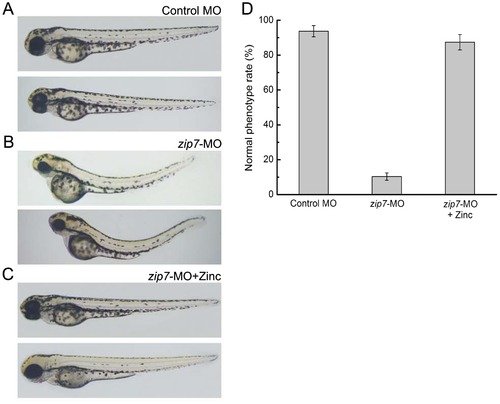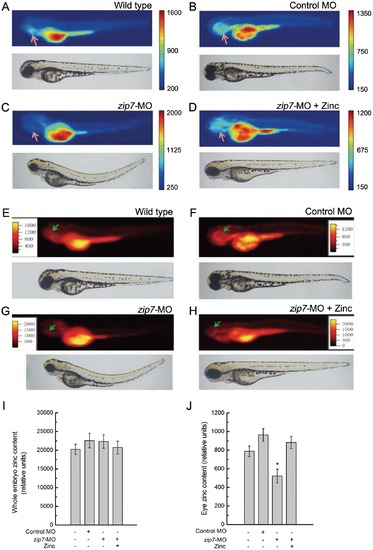- Title
-
Slc39a7/zip7 Plays a Critical Role in Development and Zinc Homeostasis in Zebrafish
- Authors
- Yan, G., Zhang, Y., Yu, J., Yu, Y., Zhang, F., Zhang, Z., Wu, A., Yan, X., Zhou, Y., and Wang, F.
- Source
- Full text @ PLoS One
|
Zip7 expression during zebrafish early embryonic development in wild type embryos and in tissues of adult zebrafish. (A?F) Lateral views (anterior to the left) of WISH of zip7 expression at 12 hpf, 24 hpf, 36 hpf, 48 hpf, 60 hpf, 72 hpf, embryos. Arrows indicate the eye. (G) The zip7 mRNA expression pattern assayed by qRT-PCR normalized to β-actin transcripts in zebrafish embryos across development and at the adult stage. (H) Normalized zip7 mRNA expression levels in tissues of zebrafish adult. * P<0.05 versus muscle (1-way ANOVA, Dunnett′s multiple comparison test). |
|
Morphological phenotypes of zip7 loss with MO microinjection and/or zip7 mRNA rescue at 72 hpf embryos. (A) Fluorescent images of live 24 hpf, GFP-Reporter control embryos (n = 57/60) and GFP-Reporter+zip7-MO morphant embryos (n = 62/62) indicate inhibition of zip7-GFP reporter expression (green, white arrows) by zip7-MO. (B?D) Lateral views (anterior to the left) of embryos at 72 hpf (B) Wild type with control-MO microinjection (2 nL, 10 ng). (C) Wild type with zip7-MO microinjection (2 nL, 10 ng). (D) Wild type with zip7-MO (1 nL, 10 ng) + zip7 mRNA (bottom, 1 nL, 225 pg) microinjection. (E) Statistical analysis of microinjection of zip7-MO and zip7 mRNA phenotypes. PHENOTYPE:
|
|
Morphologic phenotypes of zip7-deficient embryos and Zn2+ (50 μM) rescue at 72 hpf. Lateral views (anterior to the left) of embryos at 72 hpf. (A)Wild type with control-MO microinjection (2 nL, 10 ng). (B) Wild type with zip7-MO microinjection (2 nL, 10 ng). (C) Wild type with zip7-MO microinjection (2 nL, 10 ng) hatching in the presence of Zn2+ (50 μM). (D) Statistical analysis of microinjection zip7-MO and Zn2+ phenotype. PHENOTYPE:
|
|
SR-XRF images and quantitative analysis of Zinc in zip7-Deficient Embryos and Zn2+ (50 μM) rescue. Lateral views (anterior to the left) of embryos at 72 hpf, arrows indicate eye. (A and E) Wild type without any microinjection, (B and F) wild type with control-MO microinjection (2 nL, 10 ng), (C and G) Wild type with zip7-MO microinjection (2 nL, 10 ng), (D and H) Wild type with zip7-MO microinjection (2 nL, 10 ng) and hatching in the presence of Zn2+ (50 μM). (A?D) Two-dimensional images of SSRF, (E?H) Three-dimensional images of SSRF. Quantitation and statistical analysis of zinc densities in wild type, control-MO, zip7-MO, and zip7-MO+zinc embryos (I and J). (I) Relative zinc content in the whole embryo, and (J) relative zinc content in the eye. *Statistical differences with corresponding wild type (t test, P<0.05). The zinc relative content was acquired by d4/d2/d1 (d4: photon counting of zinc correspondence, d2: electronic counting of light intensity, and d1: irradiation time). PHENOTYPE:
|




